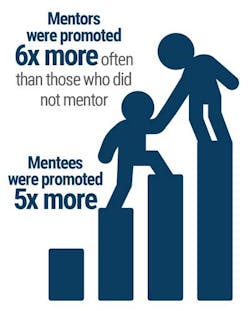Engineering Your Career, Part 3: Professional Societies and Community Groups
Engineers who invest time and energy in professional associations and community groups will quickly find that those investments pay dividends in terms of building networks of engineers and design professionals and staying technically relevant. Both of these can be critical to an engineer’s career success.
Investing in Your Profession and Community
When you join a professional association or a community group, you’ve taken an important first step in boosting your career. But that membership likely won’t pay dividends until you engage. Being a member typically includes access to various benefits, but actively engaging in the organization often leads to real career growth and acceleration of an engineer’s professional development. For example, associations are leaders in post-college training and professional development for engineers of all disciplines.
My own story serves as a good example. I first joined the National Society of Professional Engineers as a young engineer fresh out of college after being invited to a meeting by a co-worker. At that first meeting I learned about an opportunity to volunteer at the local Mathcounts competition. Mathcounts, a STEM program for 6th, 7th, and 8th graders, encourages the pursuit of high-level math courses, a prerequisite for any engineering program. I participated in Mathcounts in grade school and knew how fun it is, so I wanted to be a part of the effort. Through that engagement, I had the opportunity to be a Mathcounts coordinator for my local NSPE chapter. I also moved through the various officer positions in NSPE, including chapter president.
Serving as a chapter leader and then at the state and national levels, I learned vital leadership skills and had the opportunity to put those skills into practice. Certainly, on-the-job training is a great way to learn and grow, but learning and practicing leadership skills in the safe and relatively harmless context of a volunteer organization or professional association has a lot of benefits. I found my fellow members and officers to be extremely supportive and forgiving when I made mistakes or missteps. This is not always the case in the work environment. The experiences in Mathcounts and NSPE helped build my confidence along with my skills and networking base.
For example, serving as a committee chair in a professional association or community volunteer organization lets you work with small groups to accomplish a task or series of tasks. You have no real authority over your other members, so you must flex your skills of persuasion to achieve results beyond what you alone could accomplish.
Associations are leaders in post-college training and professional development for engineers of all disciplines.
To effectively influence team members to take action and help with various tasks, you have to paint a picture of what the team is trying to achieve and then organize the team with task assignments and a schedule for completion. This closely parallels what project managers in engineering organizations do when developing a project or product. Team members don’t usually report directly to the project manager and they have other responsibilities within the organization and outside of it. So, these skills of influence or persuasion, along with planning, organizing, and scheduling, are critical to the team’s success. And mastering those skills is critical to your development as an engineering leader.
In addition to skills development, engaging in professional associations and volunteer community organizations requires that members learn to focus on what is important to them, their careers, and their mental/physical health. In other words, members learn to balance work and outside activities, which can be a challenge for any engineer.
As a young engineer working my way up the corporate ladder, I was also a wife and mother. I didn’t have a lot of spare time, but I found a way to make time for professional and community activities while also excelling as an employee and caring for my family. These things are not mutually exclusive; they are complementary. The skills learned in one situation are helpful and applicable in the other. Balancing all of this might not be easy, but it is certainly possible. It’s also fulfilling and enriching, which is a huge motivator when it comes to maintaining the focus necessary to push forward daily.
Giving Back, Gives Back
We often talk about the desire to “give back to our profession,” an old-school way of looking at the world and our responsibilities. But maybe we need to rephrase it to be more in tune with today’s thinking. For me, it means working as hard as possible to improve the engineering profession for future generations. Or in other words, to leave things better off than how I found them.
Whether it’s sustainability, resiliency, and green approaches to our work, or improving processes and procedures for the future, it’s all about making a difference and changing things for the better. That’s a worthy goal, and one that fits the calling of a professional engineer. So, to have a rewarding and successful career, many engineers feel the need to make positive changes and “give back.”
Mentoring young professionals, for example, is one way to give back to the profession and pass on the wisdom we have learned to future generations. According to a June 2019 Forbes article, about 70% of Fortune 500 companies offer mentoring programs to employees, a sure sign those companies value mentoring.
Whether through formal mentoring programs or informal settings, spending time mentoring or being mentored can be fulfilling and enlightening. Ironically, I often leave mentoring sessions with more than I brought to the table. Spending time with people who may differ in age or background can enrich an engineer’s career while also helping others.
Committing time to mentoring and being mentored can be a challenge in today’s busy world, but the time spent is worth it. In a July 2019 Forbes article, a Sun Microsystems case study illustrated this point. Mentees in the program were promoted five times more than those who were not. And mentors were promoted six times more often than those who did not mentor anyone. On top of that, retention rates were significantly higher for mentees (72%) and mentors (69%) than for employees not participating in the program (49%). It seems investing time in mentoring is critical to career growth and development.
Building a Network
Having an effective network is more than just meeting folks, having casual conversation, and connecting on social media. To illustrate this point, engineers can create a bubble diagram of their network. It starts with a circle in the middle of the page that represents the engineer, and then bubbles are drawn representing various people in their life including friends, family, and co-workers. This lets engineers “see” their various relationships and then focus on strengthening those important to career advancement and other goals. For me, that includes family and professional relationships. Over the years, I have revisited and updated my network’s bubble diagram, which has benefitted me.
Having an effective network is more than just meeting folks, having casual conversation, and connecting on social media.
Engineers who are exploring their networks should consider not only their company and family, but also volunteer organizations, alumni and community groups, and others who influence their lives. They will likely find that a rewarding engineering career is about more than designing great projects; it is truly about the people in their lives.
Staying Technically Relevant
Engineers are technical professionals and staying up to date on technical advances in their fields is vital to their career development. I have sat across the table from numerous young engineers who talk about wanting to be project managers and leaders in their field. But they don’t seem to understand the value of their technical knowledge and problem-solving abilities as they apply for advancement.
Engineers should focus heavily on developing their technical skills in their first five years after graduating from college. Then, as their career progresses, they may shift the focus to leadership, management, and business skills. At the same time, however, it’s advisable to pick a technical niche they find compelling and continue to take classes, read books and articles, and attend webinars in that area. Young engineers can easily become experts in their field if they put in the time. Fulfillment as a technical professional requires continual learning throughout your career.
Investment in your career development is essential to success. So use professional associations such as NSPE to achieve your goals and take advantage of the many opportunities that will come your way.
Tricia Hatley, P.E., is the immediate past president of the National Society of Professional Engineers.
This is the third part of a four-part series on how engineers must adapt in these changing times. Part I covers the challenges of engineering, Part II covers licensing and Part IV looks at risk taking.


